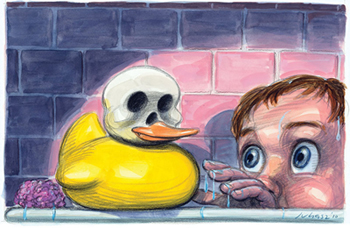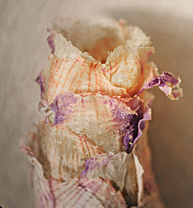sierraclub.org - sierra magazine - september/october 2010 - grapple
Chemical Reactions | I'll Bee What I Am | Up to Speed
Chemical Reactions
Here's an idea: Let's not test toxics on the kids
 Victor Juhasz
Victor Juhasz
Do you keep your household chemicals under the sink? In the garage? Actually, you keep them pretty much everywhere. There are phthalates in your medicine cabinet and flame retardants in your furniture. The cans of food in your pantry are lined with bisphenol A, while everything from your carpets to your toothpaste can contain formaldehyde. And the stuff doesn't stay put: In a recent study of 2,400 Americans, the Centers for Disease Control and Prevention found chemicals—212 in all—in the blood or urine of each.
What are these substances doing to you? No one knows. Of the 82,000 industrial chemicals registered for use in the United States, fewer than 500 have been evaluated for human safety by the EPA. That's because under the 1976 federal Toxic Substances Control Act (TSCA), industrial chemicals are presumed safe unless proved otherwise. And the standard of proof is pretty high: Since the law passed, the EPA has banned only five chemicals.
Newly proposed legislation by Senator Frank Lautenberg (D-N.J.) and Representatives Bobby Rush (D-Ill.) and Henry Waxman (D-Calif.) would reverse that burden of proof. Under their Safe Chemicals Act, industry would have to prove chemicals were safe before using them in products or releasing them into the environment. It would empower the EPA to take the worst offenders off the market quickly and would require regulators to determine the aggregate effect of exposures to a given compound from a variety of sources. (At present, a baby's exposure to phthalates from a bottle is held to have no relation to his or her exposure to the same compound from a rubber ducky.)
The chemical industry is expected to strongly oppose the legislation, but the bill's timing may be just right. In May, the President's Cancer Panel issued a report saying that "the true burden of environmentally induced cancers has been grossly underestimated" and criticizing federal regulators for being "reactionary rather than precautionary." Meanwhile, consumers are spurning products that contain suspect chemicals, like Lexan water bottles and teething rings, leaving retailers stuck with items they can't sell.
The chemical industry disparages this consumer revolt as "retail regulation," but a poll by Safer Chemicals, Healthy Families (saferchemicals.org) found that 7 out of 10 voters want to see the TSCA strengthened. —Dashka Slater
I'll Bee What I Am
 Courtesy of Jerome G. Rozen/ American Museum of Natural History
Courtesy of Jerome G. Rozen/ American Museum of Natural History
It is—to mangle a line from Neil Diamond—a solitary bee, Osmia avosetta. And though researchers did know of the species, it wasn't until a fateful day of "absolute synchronicity" this spring that two groups of scientists—one doing fieldwork near Antalya, Turkey, and the other a thousand miles away, near Sepidan, Iran—were able to observe how the female bee builds her nest from flower petals.
This careful construction involves the bee's biting off the petals and flying them, one at a time, to a half-inch crevice in the ground. After the underground nursery is lined with multihued wallpaper, the mother bee adds a coat of reinforcing mud, then a second layer of petals. She places a dollop of larvae-sustaining nectar and pollen at the bottom of the floral nest, lays her egg, carefully tucks it under the petals, and plugs the crevice with mud to fend off predators.
In about four days the egg hatches. The larva eats the food its mother has left, spins a cocoon, and waits for spring. Then it emerges as an adult and heads off on its own, perhaps to pollinate the flowers whose petals will later be fashioned into a nest. —M. P. Klier